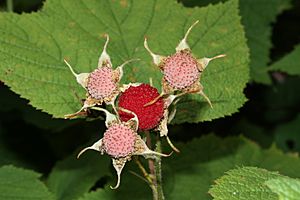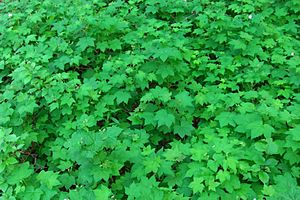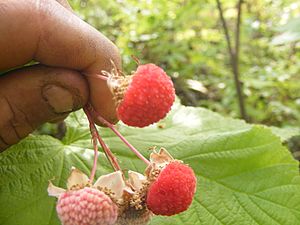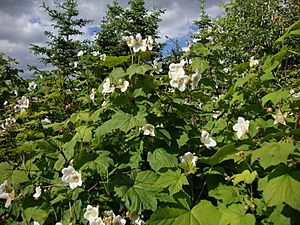Thimbleberry facts for kids
Quick facts for kids Thimbleberry |
|
|---|---|
 |
|
| Conservation status | |
| Scientific classification | |
| Kingdom: | |
| (unranked): | |
| (unranked): | |
| (unranked): | |
| Order: | |
| Family: | |
| Genus: | |
| Subgenus: |
Anoplobatus
|
| Species: |
R. parviflorus
|
| Binomial name | |
| Rubus parviflorus Nutt. 1818
|
|
| Synonyms | |
|
Synonymy
Bossekia nutkana Greene
Bossekia parviflora (Nutt.) Greene Rubacer parviflorum (Nutt.) Rydb. Rubus natkanus G.Don Rubus nutkanus Moc. ex Ser. Rubus nutkanus var. nuttallii Torr. & A.Gray Rubus nutkanus var. parviflorus (Nutt.) Focke Rubus parviflorus var. bifarius Fernald Rubus parviflorus var. grandiflorus Farw. Rubus parviflorus var. heteradenius Fernald Rubus parviflorus var. hypomalacus Fernald Rubus parviflorus subsp. velutinus (Hook. & Arn.) R.L.Taylor & MacBryde Rubus velutinus Hook. & Arn. Rubus ribifolius C.K.Schneid. |
|
Rubus parviflorus, commonly called thimbleberry, (also known as redcaps) is a species of Rubus native to northern temperate regions of North America. It bears edible red fruit similar in appearance to a raspberry, but shorter, almost hemispherical. Because the fruit does not hold together well, it has not been commercially developed for the retail berry market, but is cultivated for landscapes. The plant has large hairy leaves and no thorns.
Contents
Distribution
Rubus parviflorus is native to western North America from Alaska south as far as California, New Mexico, Chihuahua, and San Luis Potosí. Its range extends east to the Rocky Mountains and discontinuously to the Great Lakes Region. It grows from sea level in the north, up to elevations of 3,000 m (10,000 ft) in the south.
Ecology
Rubus parviflorus typically grows along roadsides, railroad tracks, and in forest clearings, commonly appearing as an early part of the ecological succession in clear cut and forest fire areas.
Thimbleberry is found in forest understories with typical flora associates including coastal woodfern (Dryopteris arguta), Trillium ovatum and Smilacina racemosa.
The fruit is consumed by birds and bears, while black-tailed deer browse the young leaves and stems.
Description
Rubus parviflorus is a dense shrub up to 2.5 meters (8.2 ft) tall with canes no more than 1.5 centimeters (0.59 in) in diameter, often growing in large clumps which spread through the plant's underground rhizome. Unlike many other members of the genus, it has no prickles. The leaves are palmate, up to 20 centimeters (7.9 in) across (much larger than most other Rubus species), with five lobes; they are soft and fuzzy in texture. The Concow tribe calls the plant wä-sā’ (Konkow language).
Flowers
The flowers are 2 to 6 centimeters (0.79 to 2.36 in) in diameter, with five white petals and numerous pale yellow stamens. The flower of this species is among the largest of any Rubus species, making its Latin species name parviflorus ("small-flowered") a misnomer.
Fruit
The plant produces edible composite fruit approximately a centimeter (0.4 inches) in diameter, which ripen to a bright red in mid to late summer. Like raspberries, it is not a true berry, but instead an aggregate fruit of numerous drupelets around a central core. The drupelets may be carefully removed intact, separately from the core, when picked, leaving a hollow fruit which bears a resemblance to a thimble, perhaps giving the plant its name.
Uses
Cuisine
Thimbleberry fruits are flatter and softer (more fragile) than raspberries, but similarly have many small seeds. Because the fruit is so soft, it does not pack or ship well, so thimbleberries are rarely cultivated commercially.
However, wild thimbleberries can be eaten raw or dried (the water content of ripe thimbleberries is quite variable), and can be made into a jam which is sold as a local delicacy in some parts of their range, notably in the Keweenaw Peninsula of Upper Michigan. Thimbleberry jam is commonly made by combining equal volumes of berries and sugar and boiling the mixture for two minutes before packing it into jars. Without sugar, the cooked berries, with a distinguishing sweet-sour taste, keep for a few days in the refrigerator.
Cultivation for ornamental purposes
Rubus parviflorus is cultivated by specialty plant nurseries as an ornamental plant, used in traditional, native plant, and wildlife gardens, in natural landscaping design, and in habitat restoration projects. The fruit has fragrance. Thimbleberry plants can be propagated most successfully by planting dormant rhizome segments, as well as from seeds or stem cuttings.
The flowers support pollinators, including of special value to Native bees, honeybees, and bumblebees. The fruit is attractive to various birds and mammals, including bears. It is the larval host and a nectar source for the yellow-banded sphinx moth.
Cultivars
Cultivars of the plant are selected for ornamental qualities, such as for their fragrant flowers and/or attractive fall foliage color.
A double-flowered form of the thimbleberry was discovered near Squamish, British Columbia, by Iva Angerman (1903–2008) of West Vancouver. This clone does not appear to be in commerce, but is grown in the Botanic Garden of the University of British Columbia, Vancouver, and in the Native Plant Garden of the Royal British Columbia Museum, Victoria.
Traditional medicine
Many parts of the plant were used in folk medicine by Native Americans. A tea made from its leaves or roots was thought to be a treatment for wounds, burns, acne, or digestive problems; a tea made from the canes was thought to be useful as a diuretic. As of 2019, there is no evidence from modern clinical research or practice that Rubus parviflorus is effective for treating any disease.
Thimbleberry leaves can be used as "toilet paper" when in the wilderness.
Gallery
-
Ripe thimbleberries foraged in New York state
See also
 In Spanish: Rubus parviflorus para niños
In Spanish: Rubus parviflorus para niños








